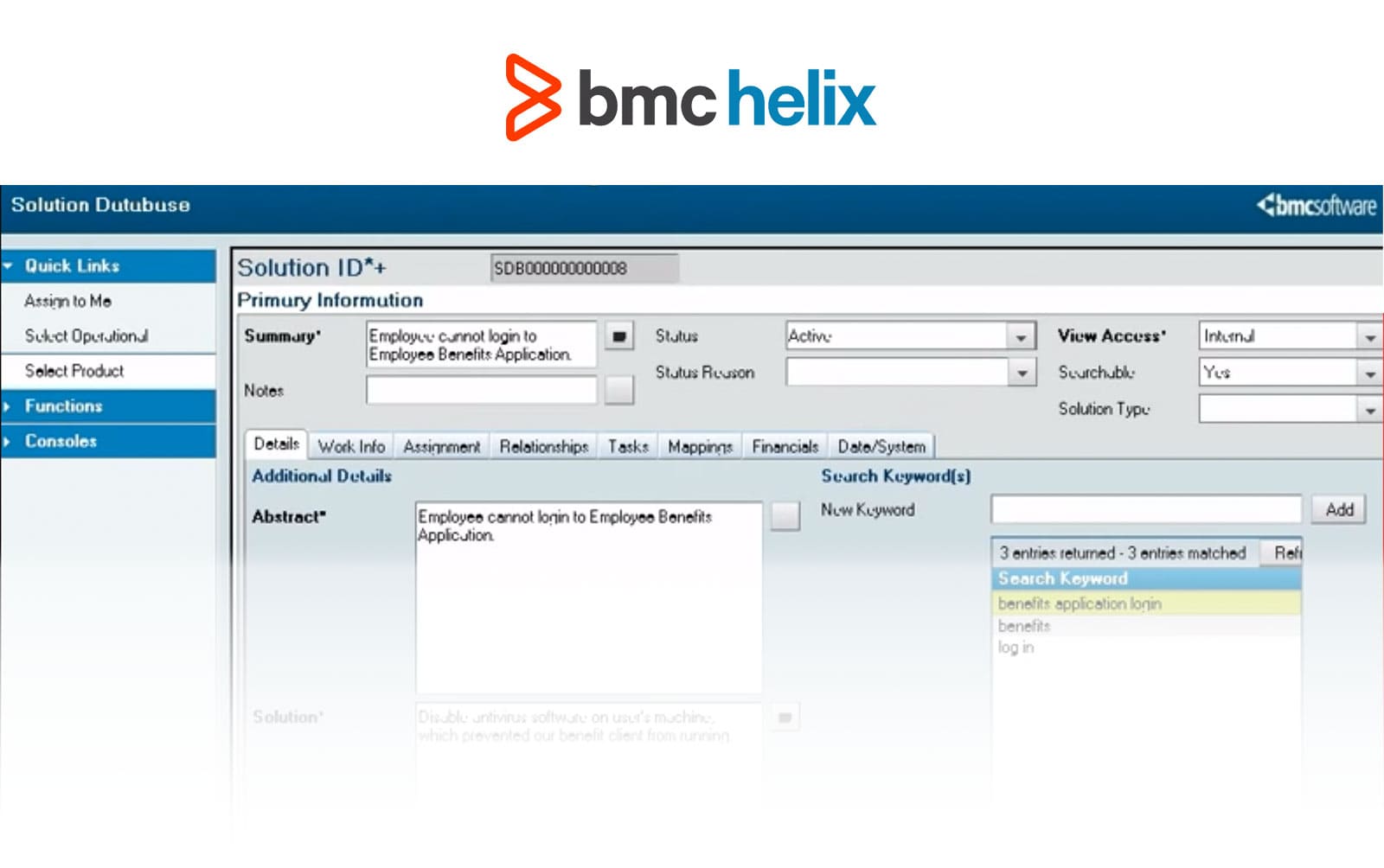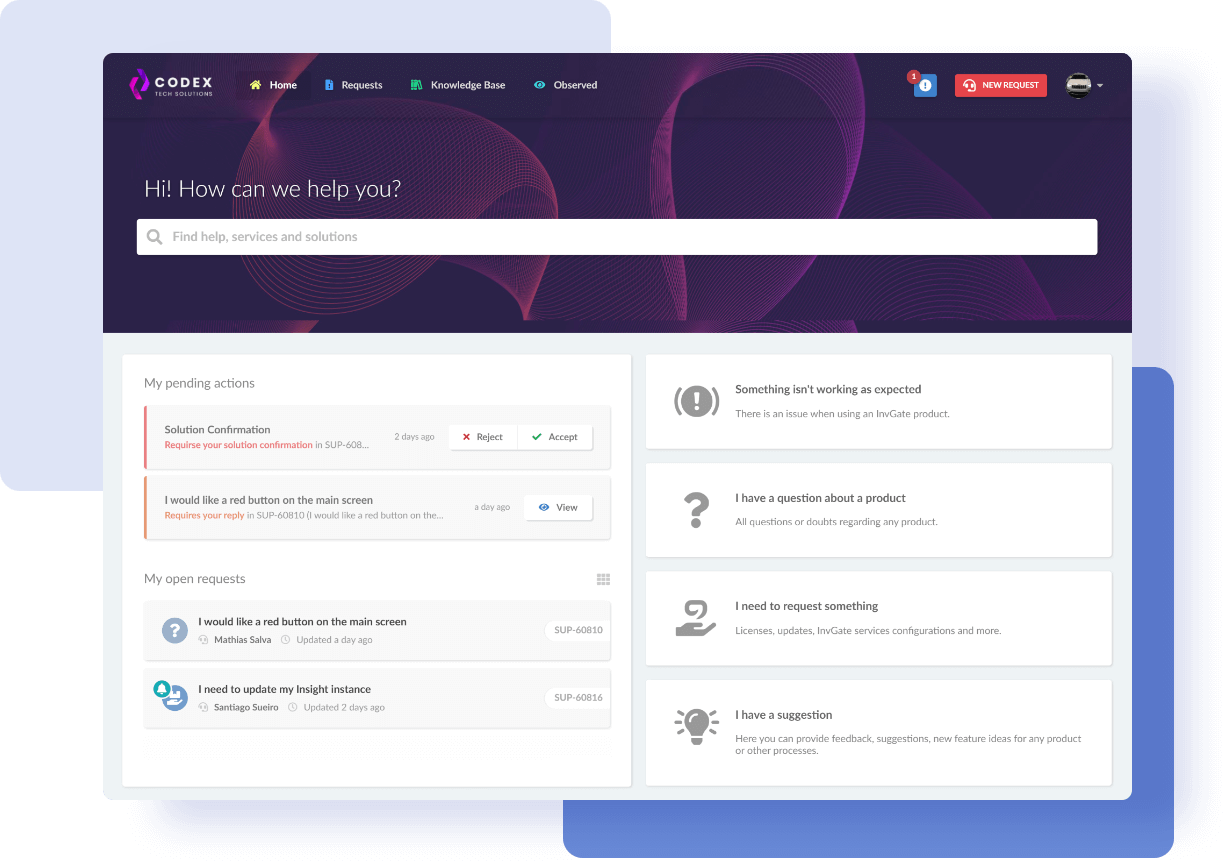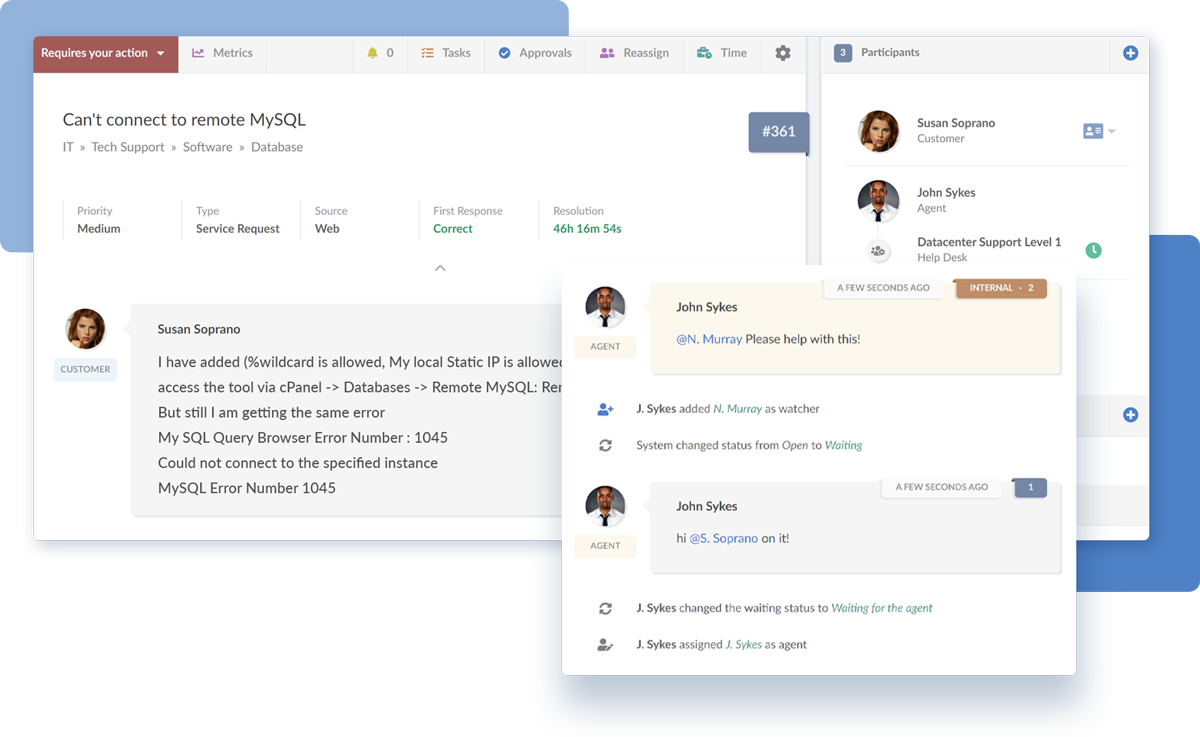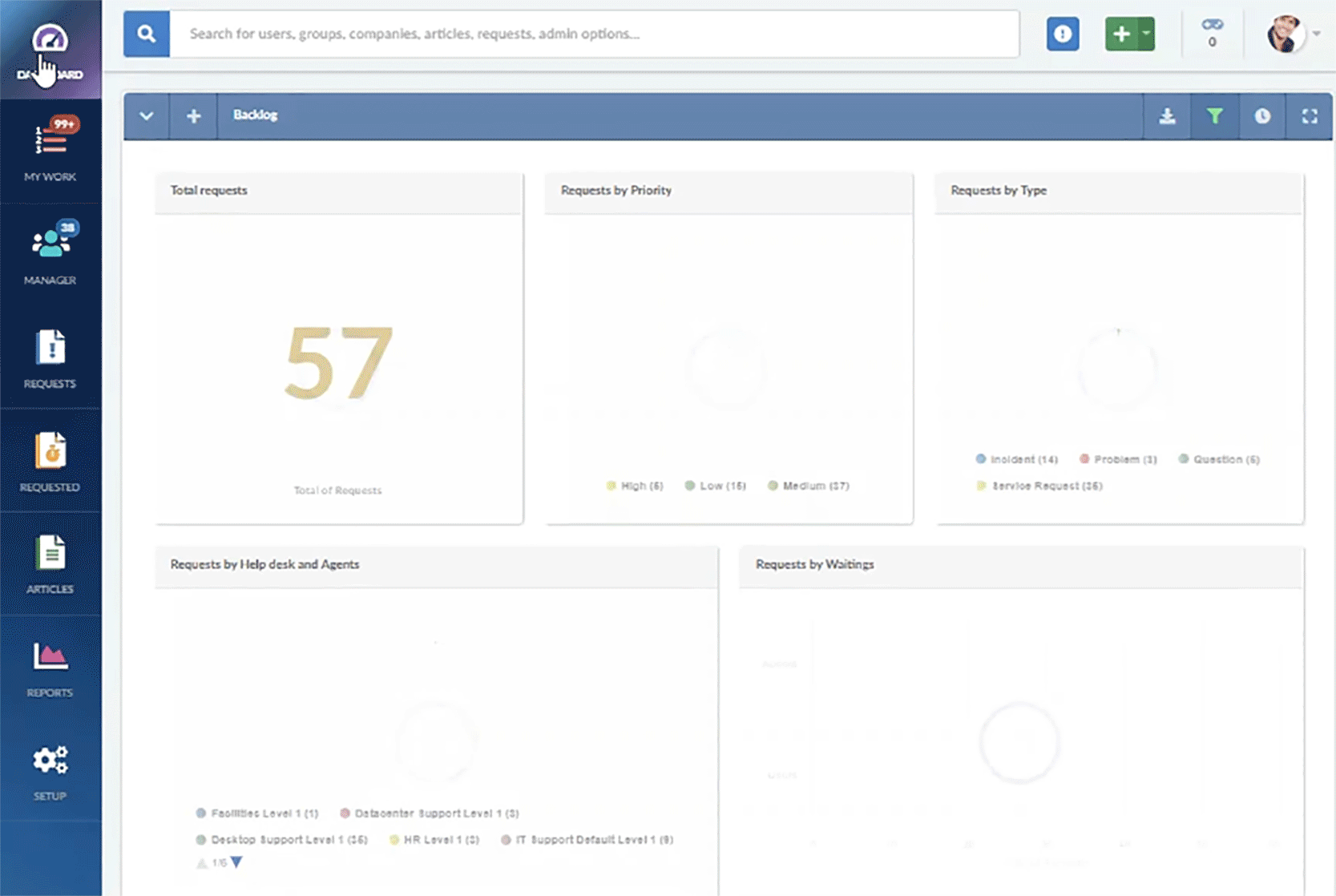Are you tasked with comparing Aranda Service Management vs. BMC Helix to find your organization's ideal IT Service Management (ITSM) solution? The decision you make can have a profound impact on your efficiency and service delivery capabilities.
With each platform offering its own unique features and capabilities, conducting a comprehensive evaluation is crucial before arriving at a decision. In this blog post, we’ll dive deep into the key aspects of Aranda Service Management and BMC Helix, shedding light on their respective strengths and weaknesses.
Moreover, we’ll also introduce you to an alternative solution that stands out in this competitive landscape: InvGate Service Management. This service desk software prioritizes digital transformation, streamlined functionalities, and the opportunity to elevate your IT operations to new heights. Let's embark on this ITSM tools comparison and discover the transformative potential of these ITSM solutions.

Table of Contents
- TL;DR
- What is Aranda Service Management?
- What is BMC Helix?
- Considering InvGate Service Management as an ITSM solution alternative
TL;DR
- Aranda Service Management provides a unified web console, flexible installation options, and support, it is disheartening that there are no user reviews available on reputable platforms.
- BMC Helix receives accolades for its advanced functionalities, customizable options, responsive customer support, and reliable cloud hosting. However, some users express concerns about the outdated interface, unpredictable licensing costs, and difficulties with reports and dashboards.
- InvGate Service Management rises above the rest in the realm of ITSM and ESM, boasting a robust ticketing system, intuitive user options, comprehensive reporting features, and unparalleled cost-effectiveness.
Most looked-at features by buyers
When potential buyers evaluate options for IT Service Management, they focus on specific features that meet their organization's needs. It is crucial to understand these desired features in order to make well-informed decisions.
Now, let's explore the main factors that prospective buyers typically take into account when comparing ITSM tools.
- Scalability - Organizations with evolving needs prioritize solutions that can adapt to their growth and accommodate customization. The software should allow the creation of custom fields, workflows, and extensions/plugins to meet unique business requirements.
- Support automation and Workflow Management - Buyers actively seek software solutions that offer automation capabilities to streamline routine tasks like ticket routing, approvals, and escalations. These automation features contribute to increased efficiency and productivity.
- User experience and interface - Buyers prioritize platforms with user-friendly interfaces that are easy to navigate, as this encourages user adoption and improves productivity. Mobile accessibility is also important, especially for organizations with remote or mobile workforces.
- Self-service portal and knowledge base - Buyers highly value having a self-service portal that enables end-users to independently resolve common issues and access relevant information without direct assistance.
- Ticket Management solution - Buyers recognize the importance of a comprehensive system for managing customer inquiries and support requests. This feature enables efficient tracking, assignment, and resolution of tickets within the help desk software.
- ITIL compliance: Many organizations prioritize solutions that adhere to ITIL best practices. Buyers may focus on solutions that support ITIL processes such as Incident Management, Problem Management, Change Management, and Asset Management.
- Customization and flexibility - Buyers look for software solutions that can be customized to align with their business needs. Having flexibility in tailoring the platform to unique workflows and processes enhances user satisfaction and overall effectiveness.
- Optimized IT service catalog - Organizations often require a centralized platform for users to request specific IT services or resources. This streamlined IT service catalog simplifies service requests, improves visibility, and assists in effective service delivery management.
- Efficient IT Asset Management - Users prioritize software that offers strong capabilities for managing IT assets, including accurate inventories and optimized resource utilization within their organizations.
- Insightful reporting - Buyers seek help desk software with robust reporting tools like dashboards and reports to gain valuable insights into their IT operations and performance. These data-driven insights facilitate informed decision-making and continuous service improvement.
- Seamless integration capabilities - Integration with other systems and applications is a critical requirement for buyers to ensure smooth data flow and process automation. The ability to integrate with existing tools (particularly ITAM tools) and platforms is highly valued for improved efficiency and a unified user experience.
- Pricing and support - Buyers consider the cost-effectiveness of the solution, including licensing models, subscription plans, and additional costs for features or users. The availability of reliable customer support, comprehensive documentation, and accessible training resources also play a significant role in the decision-making process.
What is Aranda Service Management?
Aranda Service Management, the primary software solution offered by Aranda Software, enables businesses to efficiently handle various processes and deliver support for different case types. This comprehensive software is specifically designed to assist businesses in effectively managing requests, incidents, problems, and changes, all from a centralized console.
In addition, the Colombian company specializing in IT services and Infrastructure Management provides a range of other software products that adhere to ITIL best practices. Among these offerings is Aranda Asset Management, which focuses on delivering value to businesses in the Latin American region. With a strong presence in 10 Latin American countries, Aranda Software offers flexible licensing options, including Cloud, On-premise, Hybrid, and SaaS models.
What users like from Aranda Service Management
As of the time of writing, the company's website highlights the following benefits. There are no accessible reviews on popular platforms like Gartner, G2, or Capterra, which could provide additional insights from user perspectives.
- Design and usability - Users appreciate the software's intuitive interface, which enables easy configuration, fast loading times, and overall user-friendliness. These aspects contribute to a positive user experience.
- Unified web console - The platform offers a unified web console that can be accessed through a fully web-based platform. This integrated and centralized suite eliminates the need to install a console on individual computers.
- On-premise/Cloud mode - Users can choose installation options that suit their infrastructure needs and organizational preferences. They can opt for either an on-premise or cloud-based deployment.
- Rapid implementation - The platform aims to expedite the implementation process by providing default configurations, templates, and models. These resources are readily available to accelerate the configuration process and ensure a quick setup.
- Local support in Spanish - The tool offers a specialized and certified support team available in Latin America. Users can receive assistance in their preferred language, ensuring effective support services.
- Aranda Query Manager included - Users with an ADM package license can benefit from the Aranda Query Manager feature. This advanced reporting solution offers a customizable dashboard, enhancing reporting capabilities.
What users don’t like from Aranda Service Management
Due to the absence of reviews or feedback on platforms such as Gartner, G2, or Capterra, it is difficult to identify specific complaints or criticisms about Aranda Service Management. Since there are no user perspectives or experiences shared on these platforms, no negative aspects or dislikes have been brought to light.
What’s Aranda Service Management’s argument over BMC Helix?
It is difficult to directly compare Aranda Service Management's argument over BMC Helix due to the limited information available on user perspectives and feedback for Aranda Service Management. However, based on the provided pros and cons for each platform, here are some potential arguments that Aranda Service Management might make in comparison to BMC Helix.
- Design and usability - Aranda Service Management could argue that its software offers an intuitive interface, faster loading times, and overall better user-friendliness.
- Unified web console - Aranda Service Management may emphasize that its unified web console provides a more integrated and centralized suite, eliminating the need to install a console on individual computers.
- Installation options - Aranda Service Management might argue that its platform provides more flexibility by offering both on-premise and cloud-based deployment options, allowing users to choose the installation option that best suits their infrastructure needs and organizational preferences.
- Rapid implementation - Aranda Service Management could claim that its platform's expedited implementation process, with default configurations, templates, and models readily available, leads to a quicker setup.
- Local support in Spanish - Aranda Service Management might highlight its specialized and certified support team available in Latin America, providing support services in the preferred language of users.
What is BMC Helix?

BMC Helix is a Service Management platform provided by BMC Software, an American multinational IT company. Its main purpose is to assist organizations in overcoming challenges associated with managing their IT services. The platform offers various features and capabilities that aim to simplify IT processes and enhance user experiences.
BMC Software, founded in 1976 and headquartered in Houston, Texas, specializes in providing software solutions and services for IT operations management. Their product portfolio includes IT Service Management, IT Asset Management, IT Operations Management (ITOM), and DevOps solutions. By offering these products, BMC helps organizations automate processes, manage assets, and improve IT performance.
What users like from BMC Helix
Users have expressed positive feedback about BMC Helix, as evidenced by Gartner reviews. Now, let's explore these benefits.
- Enhanced features and customization - Users appreciate the platform's evolution, which brings new features and improved integration with third-party vendors. It allows customization to meet company needs, delivering a clean and tailored user experience.
- Stable and reliable cloud hosting - BMC Helix provides a stable and reliable cloud hosting environment, ensuring consistent performance and uptime for users.
- Customer-focused and user-friendly interface - The Helix Remedy Platform prioritizes customer satisfaction and offers a user-friendly experience. The Digital Workplace portal stands out with its modern and intuitive interface.
- Responsive support - Users find the SAAS group responsive and helpful, offering timely support. The customer success team is proactive in ensuring successful implementation and tool usage.
What users don’t like from BMC Helix
Although BMC Helix has its strengths, it has also faced criticism from customers, as reported by reputable sources like Gartner. Let's now examine some of the concerns raised.
- Complexity and training requirements - While customization is appreciated, some users find the tool to be complex and require intensive training. This complexity can hinder adoption and efficiency for certain users.
- Unpredictable licensing costs - Users mention that licensing costs can be unpredictable and inflexible, causing budgeting and resource allocation difficulties.
- Inconsistent experience and poor cross-platform integration - Users report inconsistent experiences and a lack of seamless integration across different platform modules. This leads to a fragmented user experience and hinders productivity.
- Limitations and missing features - Users mention limitations and missing features, particularly regarding customization in SmartIT and certain capabilities in newer versions of BMC Helix.
- Outdated UI and mid-tier user experience - The user interface is considered outdated and not user-friendly. Additionally, the mid-tier user experience is reported to be unsatisfactory, negatively impacting usability and efficiency.
- Support issues and lack of SLAs - Resolving issues can sometimes take a long time, and working with back-end teams can be frustrating. Users express concerns about support policies and Service Level Agreements (SLAs) in the SAAS environment.
- Complicated report and dashboard creation - Users find the process of creating reports and dashboards to be complicated, which can impede effective data analysis and reporting.
What’s BMC Helix’s argument over Aranda Service Management?
Here are the potential arguments that BMC Helix might make in comparison to Aranda Service Management.
- Enhanced features and customization - BMC Helix could argue that its platform offers a wide range of enhanced features and improved integration with third-party vendors.
- Stability and reliability - BMC Helix may highlight its track record of providing a stable and reliable cloud hosting environment, ensuring consistent performance and uptime for users.
- Customer-focused and user-friendly interface - BMC Helix could assert that its Helix Remedy Platform prioritizes customer satisfaction and offers a user-friendly experience.
- Responsive support - BMC Helix might emphasize its responsive and helpful SAAS group, offering timely support to users. It may highlight the proactive nature of the customer success team in ensuring successful implementation and tool usage.
- Comprehensive product portfolio - BMC Helix may argue that its broader product portfolio provides a more comprehensive and integrated solution.
Considering InvGate Service Management as an ITSM solution alternative
In the competitive market of IT Service Management, Aranda Service Management and BMC Helix are recognized as prominent competitors. However, it is crucial to explore alternative solutions that closely align with your organization's unique needs. In this context, InvGate Service Management emerges as an enticing option that merits careful consideration.
Now, let's delve into the extensive features of InvGate Service Management that make it a valuable choice for meeting your organization's ITSM requirements.
Strong self-service capabilities
InvGate Service Management provides robust self-service functionalities, including a user-friendly portal, an extensive IT service catalog, and a knowledge base. These features empower end-users to independently resolve common issues, access various IT services, and utilize self-help resources, thereby reducing the workload on IT staff.

Comprehensive Asset Management
Integrating InvGate Service Management with InvGate Asset Management provides organizations with a holistic view of their IT ecosystem, leading to improved service delivery and reduced downtime. InvGate Asset Management offers features such as IT Asset Discovery, Inventory Management, Software License Management, and maintenance schedules.

Outstanding user experience
InvGate Service Management prioritizes delivering an exceptional user experience through meticulous design and adherence to UI/UX best practices. Its intuitive interface promotes quick adoption, reduces the need for extensive training, and ensures a user-friendly design that maximizes productivity.
Robust Ticketing and Incident Management
InvGate Service Management offers powerful features for efficient tracking, collaboration, and resolution of tickets. It includes automated ticket routing, customizable workflows, and SLA Management, empowering IT teams to effectively handle and prioritize incidents.

Simplified configuration and setup
InvGate Service Management simplifies the configuration and setup process with a user-friendly, no-code/low-code approach. This allows both novice and experienced users to implement the system without extensive technical expertise. The platform offers straightforward configuration options, enabling organizations to leverage its powerful ITSM capabilities quickly.
Customization and flexibility
InvGate Service Management offers flexible deployment options, allowing organizations to choose between on-premise or cloud-based solutions. This adaptability ensures that the platform can cater to the specific requirements of different sectors and industries.
Comprehensive reporting and analytics
InvGate Service Management provides extensive reporting and analytics functionalities, enabling organizations to gain valuable insights into their IT operations and performance. The platform offers ready-to-use reports and customizable dashboards, allowing IT teams to analyze data, identify patterns, and make informed decisions to enhance their services.

Cost-effective solution
InvGate Service Management offers a cost-effective solution without compromising functionality. It provides a comprehensive range of ITSM features at a competitive price, making it an appealing choice for organizations seeking affordability without sacrificing capabilities. Compared to alternatives like Aranda Service Management and BMC Helix, InvGate Service Management strikes a balance between cost and functionality.
ITIL-certified readiness
InvGate Service Management has achieved the prestigious ITIL4 certification from PINK Elephant, demonstrating its commitment to upholding ITSM excellence. Whether organizations are starting their ITIL journey or managing complex operations, InvGate Service Management provides a user-friendly and feature-rich experience aligned with industry best practices.
Focused on ITSM with ESM extension
InvGate Service Management is purpose-built for ITSM and seamlessly extends its capabilities to Enterprise Service Management (ESM). This allows operational departments to improve their processes and fully embrace the benefits of digital transformation. With a primary focus on ITSM and strong performance in ESM, InvGate Service Management facilitates streamlined workflows and comprehensive digital transformation initiatives across all departments.
Fast ROI and ongoing innovation
InvGate Service Management ensures a rapid return on investment through efficient implementation processes. Within weeks, organizations can begin experiencing the benefits of this robust ITSM solution. Additionally, regular feature updates keep users at the forefront of technology without incurring additional costs.
Next steps
In comparing Aranda Service Management vs. BMC Helix, both platforms have their own strengths and weaknesses. Organizations seeking a Service Management solution must carefully consider their unique requirements and preferences before deciding.
In addition, it is advisable to explore alternatives beyond both platforms. One such alternative worth considering is InvGate Service Management. With its focus on delivering an exceptional user experience and robust functionalities, InvGate Service Management presents a compelling choice for organizations seeking to optimize their IT Service Management operations.
If you want to discover how InvGate Service Management can benefit your organization, explore our live demo for a hands-on experience. Take the next step towards optimizing your IT Service Management operations with a solution tailored to your unique requirements!
















